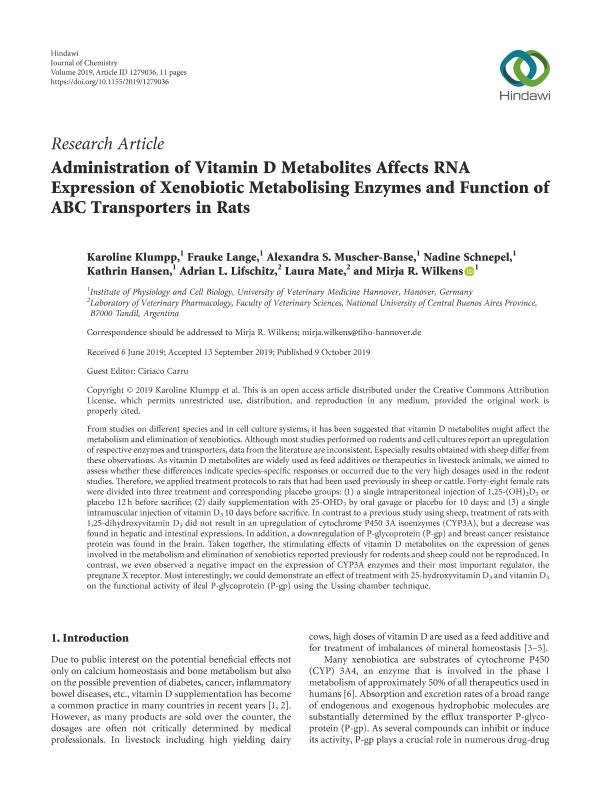Mostrar el registro sencillo del ítem
dc.contributor.author
Klumpp, Karoline
dc.contributor.author
Lange, Frauke
dc.contributor.author
Muscher-Banse, Alexandra S.
dc.contributor.author
Schnepel, Nadine
dc.contributor.author
Hansen, Kathrin
dc.contributor.author
Lifschitz, Adrian Luis

dc.contributor.author
Maté, María Laura

dc.contributor.author
Wilkens, Mirja

dc.date.available
2020-05-15T21:05:17Z
dc.date.issued
2019-10
dc.identifier.citation
Klumpp, Karoline; Lange, Frauke; Muscher-Banse, Alexandra S.; Schnepel, Nadine; Hansen, Kathrin; et al.; Administration of Vitamin D Metabolites Affects RNA Expression of Xenobiotic Metabolising Enzymes and Function of ABC Transporters in Rats; Hindawi Publishing Corporation; Journal of Chemistry; 2019; 10-2019; 1-11
dc.identifier.issn
2090-9071
dc.identifier.uri
http://hdl.handle.net/11336/105299
dc.description.abstract
From studies on different species and in cell culture systems, it has been suggested that vitamin D metabolites might affect themetabolism and elimination of xenobiotics. Although most studies performed on rodents and cell cultures report an upregulationof respective enzymes and transporters, data from the literature are inconsistent. Especially results obtained with sheep differ fromthese observations. As vitamin D metabolites are widely used as feed additives or therapeutics in livestock animals, we aimed toassess whether these differences indicate species-specific responses or occurred due to the very high dosages used in the rodentstudies. -erefore, we applied treatment protocols to rats that had been used previously in sheep or cattle. Forty-eight female ratswere divided into three treatment and corresponding placebo groups: (1) a single intraperitoneal injection of 1,25-(OH)2D3 orplacebo 12 h before sacrifice; (2) daily supplementation with 25-OHD3 by oral gavage or placebo for 10 days; and (3) a singleintramuscular injection of vitamin D3 10 days before sacrifice. In contrast to a previous study using sheep, treatment of rats with1,25-dihydroxyvitamin D3 did not result in an upregulation of cytochrome P450 3A isoenzymes (CYP3A), but a decrease wasfound in hepatic and intestinal expressions. In addition, a downregulation of P-glycoprotein (P-gp) and breast cancer resistanceprotein was found in the brain. Taken together, the stimulating effects of vitamin D metabolites on the expression of genesinvolved in the metabolism and elimination of xenobiotics reported previously for rodents and sheep could not be reproduced. Incontrast, we even observed a negative impact on the expression of CYP3A enzymes and their most important regulator, thepregnane X receptor. Most interestingly, we could demonstrate an effect of treatment with 25-hydroxyvitamin D3 and vitamin D3on the functional activity of ileal P-glycoprotein (P-gp) using the Ussing chamber technique.
dc.format
application/pdf
dc.language.iso
eng
dc.publisher
Hindawi Publishing Corporation

dc.rights
info:eu-repo/semantics/openAccess
dc.rights.uri
https://creativecommons.org/licenses/by/2.5/ar/
dc.subject
VITAMIN D
dc.subject
XENOBIOTICS
dc.subject
TRANSPORTERS
dc.subject.classification
Otras Ciencias de la Salud

dc.subject.classification
Ciencias de la Salud

dc.subject.classification
CIENCIAS MÉDICAS Y DE LA SALUD

dc.subject.classification
Ciencias Veterinarias

dc.subject.classification
Ciencias Veterinarias

dc.subject.classification
CIENCIAS AGRÍCOLAS

dc.title
Administration of Vitamin D Metabolites Affects RNA Expression of Xenobiotic Metabolising Enzymes and Function of ABC Transporters in Rats
dc.type
info:eu-repo/semantics/article
dc.type
info:ar-repo/semantics/artículo
dc.type
info:eu-repo/semantics/publishedVersion
dc.date.updated
2020-04-24T17:46:46Z
dc.journal.volume
2019
dc.journal.pagination
1-11
dc.journal.pais
Reino Unido

dc.journal.ciudad
Londres
dc.description.fil
Fil: Klumpp, Karoline. University of Veterinary Medicine Hannover. Institute of Physiology and Cell Biology; Alemania
dc.description.fil
Fil: Lange, Frauke. University of Veterinary Medicine Hannover. Institute of Physiology and Cell Biology; Alemania
dc.description.fil
Fil: Muscher-Banse, Alexandra S.. University of Veterinary Medicine Hannover. Institute of Physiology and Cell Biology; Alemania
dc.description.fil
Fil: Schnepel, Nadine. University of Veterinary Medicine Hannover. Institute of Physiology and Cell Biology; Alemania
dc.description.fil
Fil: Hansen, Kathrin. University of Veterinary Medicine Hannover. Institute of Physiology and Cell Biology; Alemania
dc.description.fil
Fil: Lifschitz, Adrian Luis. Consejo Nacional de Investigaciones Científicas y Técnicas. Centro Científico Tecnológico Conicet - Tandil. Centro de Investigación Veterinaria de Tandil. Universidad Nacional del Centro de la Provincia de Buenos Aires. Centro de Investigación Veterinaria de Tandil. Provincia de Buenos Aires. Gobernación. Comision de Investigaciones Científicas. Centro de Investigación Veterinaria de Tandil; Argentina
dc.description.fil
Fil: Maté, María Laura. Consejo Nacional de Investigaciones Científicas y Técnicas. Centro Científico Tecnológico Conicet - Tandil. Centro de Investigación Veterinaria de Tandil. Universidad Nacional del Centro de la Provincia de Buenos Aires. Centro de Investigación Veterinaria de Tandil. Provincia de Buenos Aires. Gobernación. Comision de Investigaciones Científicas. Centro de Investigación Veterinaria de Tandil; Argentina
dc.description.fil
Fil: Wilkens, Mirja. University of Veterinary Medicine Hannover. Institute of Physiology and Cell Biology; Alemania
dc.journal.title
Journal of Chemistry
dc.relation.alternativeid
info:eu-repo/semantics/altIdentifier/url/https://www.hindawi.com/journals/jchem/2019/1279036/
dc.relation.alternativeid
info:eu-repo/semantics/altIdentifier/doi/http://dx.doi.org/10.1155/2019/1279036
Archivos asociados
